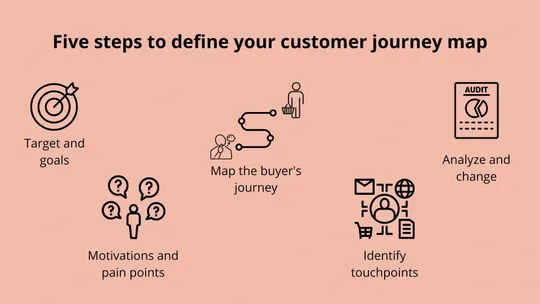
Understanding the minds of customers can be challenging. It is not something to assume or predict based on your internal perspective. You will need a customer journey map to understand the wants and needs of your customers.
The customer journey is the process by which a customer interacts with a company in order to achieve a goal.
You might think the process of buying a product is simple, companies offer a product or service and customers buy it. But it’s actually way more complex than that. From the time a customer is introduced to a product to when they purchase it, they go through the buyer’s journey.
On this journey, customers might see ads, speak to a customer service representative, or attempt to check out. These are stops along the journey that affect their actions. Understanding the process and its consequences on customer interactions will allow your business to plan and prepare to drive customers towards a sale. But it’s not just about understanding this process, having a diagram to simplify and explain this process can be a useful resource for you and your employees. That’s when designing a customer journey map comes into play. Mapping the customer journey helps you refine your marketing strategies to provide excellent customer experiences and drive sales.
The customer journey gives you a roadmap of how your audiences see your business, leading you through every customer point of contact. Each customer journey can vary depending on the dynamics of a business. However, these are the steps to map the customer journey:
1. Set your target and your goals
Identifying goals and setting targets are essential first steps in learning how to make a customer journey map. Based on your goals set your buyer persona. This will remind you to direct every aspect of your customer journey map towards them.
2. Identify motivations and pain points
Considering your buyer personas is so important to understand their motivations and pain points in the later stages of learning how to make a customer journey map.
3. Map the buyer’s journey
It’s important to note the different stages of the buyer’s journey in order to be able to provide more personalized experiences for your customers. There are 3 different stages that describe how your customers advance along their path to purchase: the awareness stage, the consideration stage, and the decision stage.
The awareness stage is that moment when the customer realizes that has a problem; the consideration stage is when the buyer defines the problem and looks for solutions and the decision stage is the moment when the buyer evaluates and decides what is the best solution.

4. Identify the touchpoints
Touchpoints refer to the many channels through which a customer may encounter your brand. These are important because they are where the opportunities to make the right impression on the customer will take place.
5. Analyze and make the necessary changes
Analyze your map and find where your customer’s needs aren’t being met. With the help of your visualized customer journey map, you can ensure those needs and pain points are always addressed.
The process of mapping your customer journey takes time and resources, which as a small business owner you don’t always have. Contact us!We are here to help you strategize, plan and execute.




